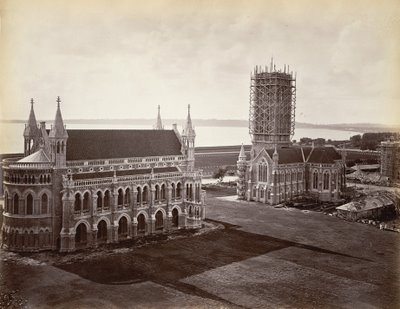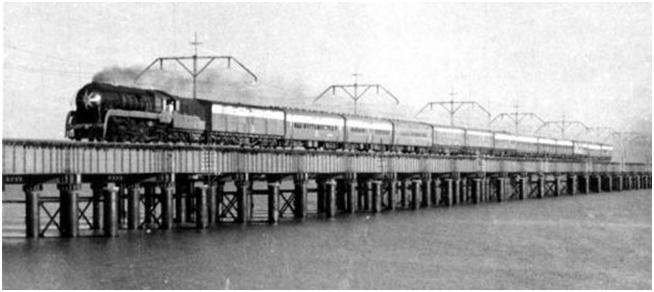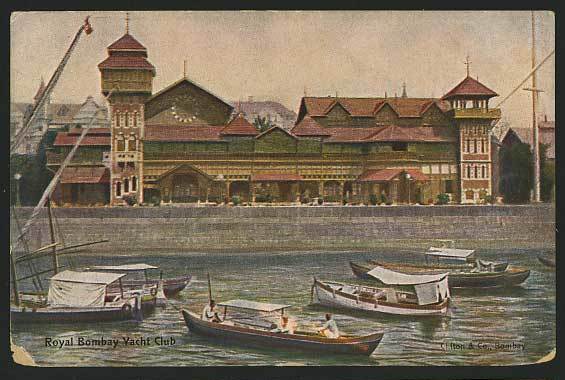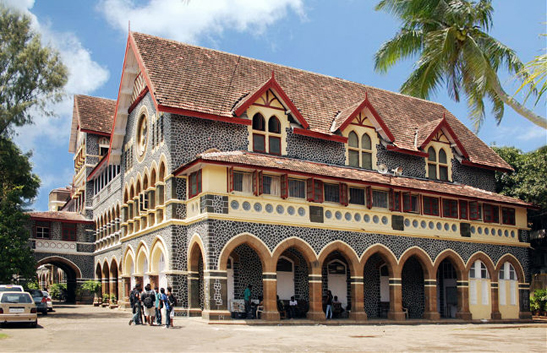From a sleepy Koli fishing hamlet to the financial capital of India, Mumbai has come a long way. The Portugese who were its earlier occupants gave it its name – ‘Bom Bai’ or ‘The Good Bay’. Initially an archipelago of 7 islands, this port city rose to prominence after the British East India Company deemed it fit for trading and shifted base from Surat. After a series of reclamations and massive construction efforts, Bombay became what is it today – A mega metropolis. Join us in capturing this iconic journey, through seamless images of the past & the present.
Old Mumbai: The Reclamation
The Archipelago and Its reclamation: The 7 islands of Colaba , Mazagaon, Old Woman’s Island, Wadala, Mahim, Parel, and Matunga-Sion, underwent a series of reclamations, forming the island city of Mumbai that we see today. Full story here.


Old Mumbai in photos: Relieve the charm of the golden days

Source: Pinterest
Old Bombay, a century ago, was just as busy as it is today.

Source: Pinterest
Old Bombay radiating the same vibe as it is now, some things just don’t change.

Source: Pinterest
Throwback to the days when Mumbai used to be Bombay.

Source: Pinterest
Busy streets of Mumbai in the 90s.
Old Mumbai photos: A glimpse of the city in olden days and today
Here’s a look at the old Mumbai photos. The rare pictures of Bombay show the prominent landmarks and popular tourist sites in the city during the later years of 1800s and early 1900s.
Gateway of India
The former pier of Apollo Bander, now replaced by the ever popular Gateway of India, a 26m high archway built to commemorate the arrival of King George V and Queen Mary.


Churchgate Railway station
Bombay was a walled city and Churchgate, now called Veer Nariman Street was one of of three wall gates. It is now home to a new and revamped Churchgate railway station.



Victoria Terminus
Where gothic meets mughal. This lovely railway terminus building Victoria Terminus, now called the Chatrapati Shivaji Maharaj Terminus in old Bombay as shown in the picture, was built in 1887 and is the busiest railway station in India.


Asiatic Town Hall
This iconic library founded in 1830 and is known to house some very rare book editions, including one of only two known original copies of Dante’s Divine Comedy.


Bombay University
Iconic. Mammoth. Ancient. One of the oldest public universities in Maharashtra, the University of Mumbai is a landmark structure and is home to the famous Rajabai Tower.



Bhendi Bazaar
The market with the curious etymology. This area was north of Crawford Market and the British referred to it as “Behind the Bazaar”. The natives picked this up as “Bhendi Bazaar” and the named stayed since.


Crawford Market
One of South Mumbai’s most famous & busiest markets where even dogs, cats & endangered species are sold. The architecture is predominantly a blend of Norman & Flemish styles.


Bhayander Bridge
Built over the Bayander creek and connecting Bayander to Naigon this bridge was so short that very few navigation vessel could pass through.


Colaba Causeway
A land link between Colaba & Old Woman’s Island, this commercial stretch of road was the first to host horse-drawn tram cars.


Colaba Sea Face
All roads lead to the sea. Leading away from the bustling causeway are tiny perpendicular roads which lead to the serene Colaba seafront.


Dadar Station
The station that has terminals on both sides and has an odd penchant for starring in many Bollywood movies, owing to the mammoth number of local trains that pass through.

Bombay High Court
Inaugurated in 1862, Gothic Revival & early English style architecture were the inspirations behind this magnificent building of old Bombay.


Flora Fountain
Standing tall in Martyr square, this ornate fountain with the Roman Goddess Flora standing atop its restless waters, was built in 1864 to commemorate Sir Bartle Frère, the then Governor of Bombay.


Malabar Hill
Situated at a height of 50 metres, it is the highest point in South Mumbai and boasts of being one of the most upmarket residential areas in Mumbai. It is also home to the Walkeshwar Temple, founded by the Silhara kings.


Marine Drive
This iconic 4.3-kilometre-long boulevard is a C-shaped 6 lane concrete road overlooking the Arabian sea, and is home to some of the best art deco architecture in the city.


See also: Mumbai Coastal Road: All you need to know
Lamington Road
Called the IT hub of Mumbai this sleepy stretch from yesteryear is now transformed into a busy thoroughfare near Grant road station.


Oval Maidan
Measuring 22 acres in area, this recreational ground is situated in the heart on South Mumbai and overlooks many famous landmark like the Bombay High Court, & University of Mumbai.


Parsik Tunnel
Once the third largest tunnel in Asia, the Parsik Tunnel is the first railway tunnel to be built in India and is 1.3 Km in length.


Cuffe Parade
Cuffe Parade was named after T. W. Cuffe of the Bombay City Improvement Trust and was built mostly on reclaimed land. The Cuffe Parade of today is swanky & upmarket with some of its buildings reaching up to 30 storeys high.


Port of Mumbai
Is built natural deep-water harbor in the southern portion of the Ulhas River estuary and is primarily used for bulk cargo. The harbour spreads over 400 square kilometres.
The Portuguese gifted Bombay city to the British as dowry in 1661. To expand themselves in Mumbai and strengthen their hold, the British opened tenders for people to buy land and develop the same. Laxman Harishchandra Ajinkya also known as ‘Bhau’ bought the lands from the British and built three ports, namely, the British-Carnac, Clark, and Claire. Going forward, Clark was renamed as Bhaucha Dhakka.


Elphinstone Circle
Found in the Horniman Circle Gardens, and was completed in 1872, this iconic heritage building housed many luxury brands and leading publication, Hermes and The Times of India to name a few.


Yacht Club
The Royal Bombay Yacht Club was founded in 1846 in the Colaba Area, when the British took to Sailing as a sport in India. The Yatch club sits pretty, overlooking the Gateway of India & the Bombay Harbor.


Wilson College
One of the oldest colleges in India, the Wison built in 1832, is a structure built in Victorian Gothic style and is known for elevated first floor classrooms with teakwood trusses.

Mumba Devi Temple
Dedicated to the Goddess Mumba, a local incarnation of the Devi, the Mumba Devi Temple is a six century old structure and is responsible for giving Mumbai its name. Mumbai is a combination of ‘Mumbā’ and aī, Marathi for “mother”.


Interesting facts about Mumbai
- Did you know, Mumbai is a collection of seven islands. Bombay comprises seven islands, that is, Isle of Bombay, Colaba, Old Woman’s Island or Little Colaba, Mahim, Mazagaon, Parel and Worli. The metropolitan we know of today is these seven islands together.
- Pathare Prabhus and the Kolis are the original residents of Mumbai.
- Mumbai was the first to start a bus service in the city and Juhu’s aerodrome was the first in the country.
- The name Mumbai is derived from the name of the local deity – Mumbadevi. At one point of time, the city was also called Kakamuchee and Galajunkja. During the years of colonisation, multiple references of Mumbai occurred as Mombayn, Bombay, Bombain, Bombaym, Monbaym, Mombaim, Mombaym, Bambaye, Bombaiim, Bombeye, Boon Bay, and Bon Bahi. The reference of the city as Mumbai was also attributed to the Koli fisherfolk who used it since the 16th century.
- In 1664, Mumbai was acquired by the British and it was part of Catherine of Branganza’s dowry when the sister of Portugal’s king married Charles II of England.
- Mumbai’s geographical position – access from the sea from all the sides – is what has worked in favour of the city. Once the British reclaimed many areas, all the islands were linked and there was easy access across the city. With the Bombay Presidency extended till Gujarat, people started coming here for trade purposes and eventually, Mumbai became the financial capital of India.
- Mumbai is home to one of the world’s most expensive houses. Indian billionaire Mukesh Ambani’s home, Antilia, which is a 27-storey tower and is valued at around USD 2 billion, is located at Altamount Road in south Mumbai.
- The city houses many UNESCO World Heritage Sites, including the Elephanta Caves, Chhatrapati Shivaji Maharaj Terminus and the Victorian gothic and art deco ensembles of Mumbai.
Also see : What is e way login







